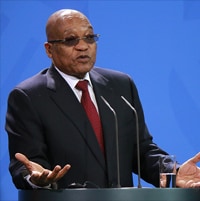South Africa's growth is impeded by long-term constraints; still, the government deserves credit for tackling reforms.
Back To Supplement

Is South Africa’s glass half empty or half full? Although its economy is stronger than many others on the continent, growth has remained stubbornly stagnant. Wages have risen enough to cut into the labor-cost advantage, but development has not gone far enough in higher-added-value industries—the so-called “middle-income trap.” South Africa has been unable to break a per capita GNP of around $11,000 in constant dollars, even though it has the highest per capita income on the continent. Economists say the country is a rare bird.
“South Africa is in a different place than most of its African peers,” says John Ashbourne of research firm Capital Economics. “You have slower population growth, better infrastructure and some serious middle-income-trap problems. Other than geography, there is not much that links South Africa to other African economies, such as Nigeria or Kenya.”
South Africa fell into an economic slump earlier than its sub-Saharan neighbors, and it will probably stay there longer. It’s central bank, The South Africa Reserve Bank, and most research institutes, along with Capital Economics, foresee no growth this year and a slight pickup in 2017.
Stalled growth on the rest of the continent can be traced to the market decline in commodities, notably oil, but South Africa’s problems are rooted internally. Long-term structural issues include a dearth of power generation capabilities—which caused several long blackouts two years ago—and an unemployment rate of nearly 27%. This year the most significant drought on record has additionally damaged agricultural output and spiked inflation.
“What we have in South Africa is a very weak economy, so when anything goes wrong there is not much to push back (from) inside,” Ashbourne says. “It is very easy for the economy to slip from low growth to no growth.”
The government, threatened by a possible ratings downgrade to junk, which would make its borrowing more expensive, has been focusing on bringing online new power generators, reforming spending and approving new legislation on labor.
“There are structural problems that need the policy changes that the government has put in place,” says Hanns Spangenberg, a senior economist at NKC African Economics. “Otherwise, low growth is going to stick around for a lot longer.”
In June, Standard and Poor’s reaffirmed its rating for South Africa: BBB- with negative outlook. That’s a notch lower than other rating agencies’ evaluations and keeps the country on the brink of junk status. Gardner Rusike, sovereign credit rating analyst at S&P, says the decision to reaffirm the rating was mostly based on trust that Jacob Zuma’s government is sticking with reforms. “It speaks to the point that the government is committed to addressing the domestic concerns,” Rusike tells Global Finance.
Come December, the rating agency is expected to make a formal decision. In discussions with labor unions and mining companies, it is trying to forge a deal that would avoid clashes with labor, such as the deadly Marikana massacre in 2012 or the 2014 platinum strike—among the longest and most expensive strikes in the nation’s history.
“The intended outcome [of these talks] is to limit the volatility or the negative consequence that has been associated with strikes,” says Rusike. “It would help the employees, it would help the companies, and it would help the overall economy.”
The bad showing the government made at local elections in August shouldn’t make it more difficult to stick to a plan of containing the public deficit, Rusike predicts, saying he does not agree with those that expect the government to change its stance. “To bring the deficit below 3% will require a lot of commitment, but we do believe that the government is on the right path to get there,” he concludes.



